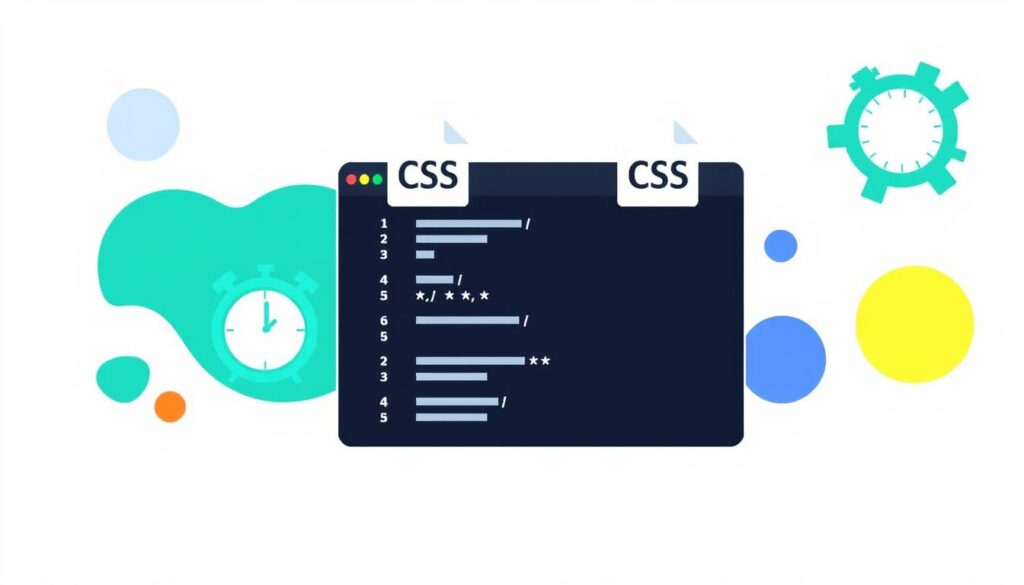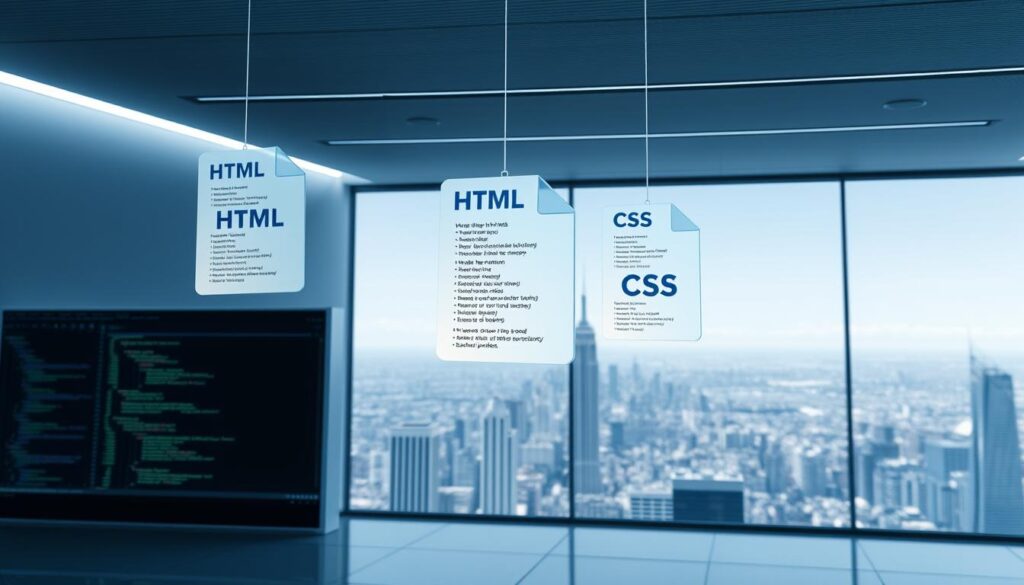Web design needs careful styling. Learning to link two CSS files to HTML is key for stunning websites. External CSS lets developers keep design separate from content. This makes web pages more flexible and easier to manage.
Web pros know that using external CSS html techniques gives them great control over looks. By linking multiple stylesheets, designers can make complex designs with clean code.
Knowing how to link CSS files helps web pros organize stylesheets better. It boosts website speed and keeps designs clean and scalable. This guide will show you how to link CSS files to your HTML documents.
Key Takeaways
- Multiple CSS files enhance design flexibility
- External CSS improves code organization
- Proper linking prevents styling conflicts
- CSS files support modular web design
- Understanding link syntax is critical for developers
Understanding the Basics of CSS File Linking
Web development needs a solid grasp of CSS and HTML connection. External CSS has changed web styling, making it easier to link and manage CSS files.
Working with external CSS in HTML brings big benefits in design and upkeep. Let’s dive into the basics of integrating stylesheets.
What is External CSS?
External CSS styles web pages by keeping CSS rules in separate files. These files have a .css extension. Instead of putting styles in HTML, developers link CSS files outside, keeping content and design separate.
- Stored in separate .css files
- Can be linked to multiple HTML pages
- Promotes consistent design across websites
Benefits of External Stylesheets
External CSS is powerful and efficient. It helps web developers in many ways. Here are some key benefits:
| Benefit | Description |
|---|---|
| Code Reusability | Use same stylesheet across multiple pages |
| Easy Maintenance | Update styles in one file, apply changes site-wide |
| Faster Loading | Browsers cache external CSS files |
Basic HTML-CSS Connection Principles
To link CSS files, you need to know a few key points. The main method is using the <link> tag in the HTML document’s <head> section.
“Clean code is like a good joke – it needs no explanation.” – Unknown Developer
Mastering external CSS lets developers make web designs that are organized, efficient, and easy to update. This makes web design more adaptable to changing needs.
The Essential Syntax for Linking CSS Files
Linking CSS files to HTML documents is key for web design. It involves using the tag in the HTML document’s
- rel=”stylesheet” – Defines the relationship between the HTML document and external CSS file
- href=”path/to/stylesheet.css” – Specifies the file path or URL of the CSS file
- type=”text/css” – Indicates the document type (optional in HTML5)
Here’s a practical example of correct linking css files syntax:
<link rel=”stylesheet” href=”main.css” type=”text/css”>
Web developers need to focus on file paths when linking CSS. Relative and absolute paths have different uses in web development.
| Path Type | Example | Usage |
|---|---|---|
| Relative Path | css/styles.css | Links files within project directory |
| Absolute Path | https://example.com/styles.css | Links external stylesheets from different domains |
Understanding these syntax basics is crucial for clean and efficient stylesheet integration in web projects.
How to Link Two CSS Files to HTML
Styling web pages gets more complex with multiple CSS files. Web developers often link two or more stylesheets to one HTML document. This makes organization and flexibility better.
To link two CSS files to HTML, you need to know the right syntax and best practices. It’s simple and done with specific HTML link tags.
Step-by-Step Implementation
To link multiple CSS files to HTML, follow these steps:
- Open your HTML document
- Find the <head> section
- Use the <link> tag for each CSS file
- Put in the correct file path
- Set the relationship as stylesheet
Common Syntax Patterns
HTML developers usually use this syntax to link multiple CSS files:
<link rel="stylesheet" href="primary-styles.css"> <link rel="stylesheet" href="secondary-styles.css">
Best Practices for Multiple Files
Organizing multiple CSS files needs planning. Here are some tips:
- Keep files small and focused
- Use clear file names
- Order stylesheets logically
- Try to use fewer files
“Efficient CSS file management is key to maintaining clean, scalable web designs.” – Web Development Experts
The order of CSS files matters. Stylesheets loaded later can change earlier styles. So, arrange them to control design order.
| CSS File Type | Purpose | Loading Recommendation |
|---|---|---|
| Reset/Normalize CSS | Standardize browser styles | Load First |
| Base Styles | Global design elements | Load Second |
| Component Styles | Specific page elements | Load Last |
Knowing how to link two CSS files to HTML helps developers make web designs more modular and easy to maintain.
How do you link CSS to HTML?
Linking CSS files to HTML is key for web developers. It involves using HTML tags to connect your stylesheet to your web page. Knowing how to link two CSS files to HTML can make your website look better and work better.
- External Stylesheet Method: The most common way is using the
<link>tag in the HTML<head>section - Multiple File Linking: You can link multiple CSS files by repeating the link tag
- Inline Stylesheet: You can also embed styles directly into HTML elements
“Clean, well-organized CSS can transform your web design from good to exceptional.” – Web Design Expert
To link two CSS files to HTML, follow these steps:
- Make sure your CSS files are in the right directory
- Use the
<link>tag for each stylesheet - Put in the correct file path
- Check your syntax and use the right paths
Experts say to keep your file structure clear and use clear names for CSS files. This makes managing complexity easier and improves code readability.
CSS File Order and Precedence Rules
Web developers need to understand cascading css files to make websites look great. The order of CSS files matters a lot. It decides how styles are applied to HTML elements.
CSS precedence html has a clear hierarchy. This hierarchy decides which styles are more important when there are many stylesheets. The browser applies styles in order from top to bottom.
“The last rule defined will typically override previous rules when conflicts occur.” – Web Styling Experts
- Inline styles have the highest precedence
- Internal stylesheets override external stylesheets
- Later linked stylesheets can overwrite earlier ones
Web developers must plan how they load stylesheets carefully. This planning is key to getting the design right. Specificity is also important in deciding which styles are shown.
| Precedence Level | Style Type | Priority |
|---|---|---|
| 1 | Inline Styles | Highest |
| 2 | Internal Stylesheet | High |
| 3 | External Stylesheet | Medium |
| 4 | Browser Default | Lowest |
Careful stylesheet management ensures predictable and controlled web design outcomes.
Managing Multiple Stylesheet Conflicts
Developers often face challenges when working with many CSS stylesheets. The order of CSS files is key in how styles are applied and solved on web pages.

Combining CSS stylesheets needs a good grasp of how browsers handle style rules. Different stylesheets can lead to design conflicts that affect your site’s look.
Cascade Order Understanding
CSS has a specific order for solving style conflicts. The browser looks at three main things:
- Importance of declaration
- Specificity of selectors
- Order of appearance in stylesheets
Specificity Hierarchy
Knowing the specificity hierarchy helps predict style application. The order is:
- Inline styles
- ID selectors
- Class selectors
- Element selectors
Resolution Strategies
To handle stylesheet conflicts, try these strategies:
| Strategy | Description |
|---|---|
| Use Specificity | Create more specific selectors to override general styles |
| !important Declaration | Override other styles with maximum priority |
| Organize File Structure | Maintain clear css file hierarchy for predictable styling |
Pro tip: Always plan your stylesheet structure carefully to minimize potential conflicts and maintain clean, manageable code.
“The key to managing CSS conflicts is understanding how browsers interpret and apply styles.” – Web Development Expert
Different Methods of Combining CSS Files
Web developers use many ways to combine CSS files. This makes websites faster and easier to manage.
- CSS Preprocessors
- Build Tool Concatenation
- Manual File Merging
- Server-Side Compilation
CSS preprocessors like Sass and Less are very useful. They let developers break down big stylesheets into smaller parts. This keeps the code neat and organized.
“Efficient stylesheet management is key to creating scalable and maintainable web designs.” – Web Development Experts
Tools like Webpack and Gulp make merging CSS files automatic. They also make the stylesheets smaller and faster.
| Method | Complexity | Performance Impact |
|---|---|---|
| Manual Merging | Low | Moderate |
| Preprocessors | Medium | High |
| Build Tools | High | Excellent |
Server-side compilation is another way to combine CSS files. It makes websites load faster by reducing the number of HTTP requests.
Using the @import Rule for CSS Files
Web developers often look for ways to link CSS files. The @import rule is a unique method for importing CSS. It has both benefits and drawbacks.
The @import rule lets developers add external stylesheets to a CSS file. This approach is different from the usual link method for managing stylesheets.
Syntax and Implementation
To use the @import rule, you need to know the right syntax. Here’s a simple example:
- @import url(‘styles.css’);
- @import url(‘responsive.css’);
Advantages and Limitations
It’s important to know the good and bad sides of the @import rule for managing stylesheets:
- It lets you load stylesheets conditionally
- It supports imports based on media queries
- It can slow down page loading
“The @import rule offers flexibility, but developers must weigh its benefits against performance issues.” – Web Development Insights
Even though powerful, @import can make pages load slower because stylesheets are downloaded one after another. Developers should think carefully about when to use it in their CSS import strategy.
Performance Considerations for Multiple CSS Files
Web developers often face challenges with multiple css files html. The performance of a website greatly affects user experience. It’s key to know how combining css stylesheets impacts page load times.

When using multiple CSS files, developers must think about several performance factors:
- HTTP Request Overhead
- Render-blocking Resources
- File Size and Complexity
“Optimization is not about writing faster code, but about writing smarter code that loads efficiently.” – Web Performance Expert
Let’s look at the main performance metrics for multiple CSS files:
| Metric | Impact | Optimization Strategy |
|---|---|---|
| Number of Requests | Increases Page Load Time | Combine or Minify Files |
| File Size | Reduces Network Performance | Remove Unused CSS |
| Render Blocking | Delays Page Rendering | Use Async Loading |
To improve performance with multiple css files html, consider these strategies:
- Minimize Total Number of CSS Files
- Use CSS Concatenation Tools
- Implement Critical CSS Techniques
- Leverage Browser Caching
By managing multiple CSS files well, developers can make websites faster and more efficient. This leads to a better user experience.
Organization Strategies for Multiple Stylesheets
Managing multiple css files in HTML projects is key. Developers must organize stylesheets well to make code easy to read and maintain.
Building a solid css file system needs planning and consistency. The right way to organize stylesheets boosts development and makes projects grow.
File Structure Best Practices
Creating a good css file hierarchy involves several steps:
- Keep global styles separate from component-specific ones
- Set up modular stylesheet directories
- Use clear naming conventions
- Have a clear folder structure
Smart Naming Conventions
Use clear and detailed names for css files:
| Convention Type | Example | Purpose |
|---|---|---|
| Functional Names | layout.css | Defines page structure |
| Component Names | navigation.css | Styles specific UI components |
| Responsive Styles | mobile-styles.css | Device-specific styling |
“Clean code is not written by following a set of rules. Clean code is written by developers who care deeply about the craft of writing code.” – Robert C. Martin
By using these strategies, developers can handle complex stylesheet setups better. This ensures web projects are easy to maintain and can grow.
Debugging Multiple CSS File Issues
Developers often face complex styling challenges when working with multiple CSS files. It’s important to understand how CSS files interact with each other. This knowledge helps solve unexpected design problems.
- Inspect element using browser developer tools
- Analyze css precedence rules
- Track conflicting stylesheet declarations
- Utilize browser’s computed styles panel
Chrome and Firefox developer tools are great for finding style conflicts. Specificity and cascade order are key to figuring out why some styles win over others.
“Effective CSS debugging is about understanding the cascading nature of stylesheets”
Here are some common debugging techniques:
| Technique | Purpose |
|---|---|
| Element Inspector | Identify applied styles |
| Computed Styles | View final rendered styles |
| Network Tab | Check CSS file loading order |
By using these methods, developers can fix styling issues fast. This leads to stronger and more reliable web designs.
Media Queries with Multiple CSS Files
Responsive web design needs smart handling of multiple CSS files. Developers must link CSS files wisely and create stylesheets for different devices. These stylesheets should adjust well to various screen sizes.

Working with multiple CSS files, media queries are key for flexible web experiences. These CSS techniques help make designs that work great on phones, tablets, and computers.
Responsive Design Implementation Strategies
Good responsive design planning is essential. Here are some important strategies:
- Create separate stylesheets for different device sizes
- Use min-width and max-width media query parameters
- Start with a mobile-first design
- Make sure CSS files load fast
Device-Specific Stylesheet Management
Managing stylesheets for different devices is all about organization. Developers use media queries to target specific screen sizes. This ensures the best look on all platforms.
“Responsive design is not about fitting content into different screens, but about creating an optimal viewing experience across devices.” – Ethan Marcotte
Important points for device-specific stylesheets include:
- Set clear breakpoint ranges
- Reduce duplicate CSS code
- Keep stylesheet structure clean and modular
By getting good at media queries and managing multiple CSS files well, web developers can make websites that adapt perfectly. These websites offer great user experiences.
Version Control for Multiple CSS Files
Managing css file hierarchy well needs strong version control strategies. Developers with many CSS stylesheets need a clear plan to track changes, work together, and keep code quality high.
Git offers great tools for managing and combining CSS stylesheets. Professional teams use certain practices to make their work easier:
- Use meaningful commit messages
- Create separate branches for stylesheet updates
- Implement code review processes
- Utilize branching strategies
Good version control means knowing how to work together well:
| Strategy | Purpose | Benefit |
|---|---|---|
| Branch Protection | Restrict direct commits to main branch | Prevent unreviewed code changes |
| Pull Request Reviews | Validate stylesheet modifications | Maintain code quality |
| Conflict Resolution | Manage simultaneous stylesheet edits | Smooth collaborative development |
“Version control is not just about tracking changes, but about creating a reliable development ecosystem.” – GitHub Engineering Team
Developers should have a clear plan for managing CSS files. Consistent naming conventions and structured repository management are key for keeping stylesheet version control clean and efficient.
CSS File Optimization Techniques
Web developers working with multiple css files html know that optimization is crucial for website performance. Combining css stylesheets efficiently can dramatically improve loading speeds and overall user experience.
Reducing the size and complexity of CSS files helps websites load faster and perform more smoothly. Developers have several powerful strategies to streamline their stylesheets.
Minification Methods
Minification removes unnecessary characters from CSS code without changing functionality. This process includes:
- Eliminating white spaces
- Removing comments
- Shortening color values
- Reducing redundant styling rules
Compression Strategies
Effective compression techniques can significantly reduce file sizes for multiple css files html. Here are key approaches:
| Compression Method | File Size Reduction | Performance Impact |
|---|---|---|
| GZIP Compression | Up to 70% | High |
| Brotli Compression | Up to 80% | Very High |
| CSS Minification | Up to 40% | Medium |
Pro tip: Always test performance after implementing optimization techniques to ensure ideal results.
“Optimization is not about making something faster, but about making it as efficient as possible.” – Web Development Wisdom
Common Mistakes to Avoid
Developers often face challenges when linking two CSS files to HTML. Knowing and avoiding these common errors can greatly improve your web styling workflow. It also helps prevent unexpected design issues.
Let’s look at the most critical mistakes that can disrupt your CSS precedence HTML implementation:
- Incorrect File Path SpecificationSpecifying wrong file paths is a common mistake. Always double-check both relative and absolute paths when linking stylesheets.
- Overcomplicating CSS LinkingAdding too much complexity can cause performance issues and make maintenance harder. Keep your linking methods simple and straightforward.
- Ignoring Stylesheet Loading OrderThe order in which you link CSS files matters. Later files can override earlier styles, leading to unexpected design outcomes.
“Precision in CSS linking is the key to maintaining clean, efficient web designs.” – Web Development Experts
To help you avoid these pitfalls, here’s a quick reference of best practices:
| Mistake | Solution |
|---|---|
| Multiple Conflicting Stylesheets | Use clear specificity and consistent naming conventions |
| Performance Overhead | Minimize the number of CSS files and use minification |
| Poor File Organization | Create a logical file structure with modular stylesheets |
By understanding these common mistakes in linking two CSS files to HTML, developers can create more robust and maintainable web designs.
Conclusion
Knowing how to link two CSS files to HTML is key for web developers. It helps them make stylesheets clean, efficient, and easy to maintain. This guide shows how to manage multiple CSS files well.
Linking CSS files right means thinking about order, performance, and organization. Web developers can make their sites better by using the best practices from this article. They learn about cascade rules and responsive design, making CSS linking more than just managing files.
As web tech keeps changing, knowing how to link CSS files is more important. Developers who learn these skills make web projects better. They make sites more scalable, responsive, and good-looking. Remember, linking CSS files well is about making web design better, not just doing it right.
Whether you’re new or experienced, learning to link CSS files can change your web development. Try out different methods and keep improving your skills. This will make your web projects better.
FAQ
What is the most common way to link CSS files to HTML?
The most common method is using the tag in the HTML document’s
section. You’ll use the syntax:
<link rel="stylesheet" href="styles.css">
. This method lets you connect one or multiple CSS files to your HTML document easily.
Can I link multiple CSS files to a single HTML document?
Absolutely! You can link multiple CSS files by adding more tags in the
section. Each CSS file loads in the order you specify. This can affect how styles are applied. For example:
<link rel="stylesheet" href="reset.css">
<link rel="stylesheet" href="main.css">
<link rel="stylesheet" href="responsive.css">
What’s the difference between using and @import for CSS files?
The tag is better for performance. It loads CSS files at the same time. @import loads them one after another, which can slow down your page. Use for external stylesheets and @import for internal ones.
How do I determine which CSS rules take precedence when using multiple files?
CSS rules follow a cascade order. It’s based on three main factors:
1. Specificity of selectors
2. Order of declaration
3. Importance (using !important)
More specific selectors win over less specific ones. Later declarations can also override earlier ones.
Are there performance considerations when linking multiple CSS files?
Yes! Each CSS file needs a separate HTTP request, which can slow down your page. To improve performance, consider:
– Combining CSS files
– Using CSS minification
– Implementing CSS compression
– Using build tools to bundle stylesheets
Can I use relative or absolute paths when linking CSS files?
You can use both. Relative paths are better for project portability:
– Relative: href="css/styles.css"
– Absolute: href="/absolute/path/styles.css"
– Full URL: href="https://example.com/styles.css"
Choose based on your project structure and deployment needs.
What are some best practices for organizing multiple CSS files?
Best practices include:
– Use descriptive file names – Organize by functionality (reset.css, layout.css, typography.css)
– Keep files modular and focused
– Follow a consistent naming convention
– Use CSS preprocessors like Sass for better organization
How can I handle responsive design with multiple CSS files?
For responsive design, consider:
– Creating separate stylesheets for different breakpoints
– Using media queries within files
– Linking device-specific stylesheets
– Implementing a mobile-first approach
– Using responsive frameworks like Bootstrap or Tailwind CSS



